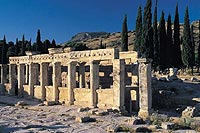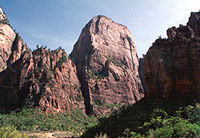| YONCA APPART HOTEL
PHOTOS
EXCURSIONS
MAP AND WEATHER
Custom Page
|
|
The ancient city of Hierapolis, the original site of Pamukkale, was known as Holy City in archaeological literature because of the abundance of temples and other religious structures in the area. Although there is limited information on the founding of the city, it is known that Eumenes II founded it and named it after Bergama’s mythical founder, Hiera, who was the wife of Telephos. It was an important centre during the Roman and Byzantine periods, and a centre of Christianity since the 4th century.
Main Street and Doors
The colonnaded main street, 1km in length, divides the city into two sections from end to end. At both ends are monumental doors outside the Byzantine ramparts because huge sections of the doors were constructed during the Roman era. On the South Byzantine Door, dating back to 5 BC, is an epitaph dedicated to Emperor Dominatian. The North Byzantine Door dating back to the same period is at the junction between the road and the ramparts.
Ramparts
The city was encircled with walls around the north, east and south, in the 5th century BC. 24 square towers were added, but the majority of these have since collapsed. Of the four entrances, two are the monumental doors and other others are small.
Great Turkish Bath Complex
Now part of the Pamukkale Museum and south of the Thermals Baths, the layout of the Roman Baths is typical of the era: A wide courtyard is at the entrance, through which is a rectangular area with large halls on both sides. There is evidence suggesting that the interior’s huge walls were covered with marble. At the north and south of the main complex are two main halls essentially used for the private use of the Emperor, and for ceremonies. The remains of the baths date back to 2nd century BC, and the area is now covered with marble and a large section is part of the Pamukkale Museum.
|
 This is one of my favorite images
This is some descriptive text.
This is one of my favorite images
This is some descriptive text. |
|
Apollion Temple
Near the Museum are the foundations of the Temple, constructed on the Plutonium spring and dedicated to Pluto, god of the underworld. It still gives off deadly poisonous gases and in front of the temple, a grate has been installed over the underground entrance to the spring to prevent inquisitive visitors. It was the site of an ancient religious cave, where Apollo met the mother goddess of Cybele, and sources suggest that she descended into the cave without being affected by the toxic fumes. The upper parts of the Temple date back to the 3rd century, and is accessible through a wide staircase.
Theatre
|
|
Here you'll create or edit a custom page for your Web site.
Use this template for any additional information you need such as products, pictures, fan clubs, links or just more information It's important to regularly change the content on your site and make updates to the information that you display. Doing this will help you to get more return visitors.
Add your link here
Here you'll create or edit a custom page for your Web site.
Use this template for any additional information you need such as products, pictures, fan clubs, links or just more information It's important to change the content on your site and make updates to the information that you display. Doing this will help you to get more return visitors.
Add your link here
|
 This is one of my favorite images
This is some descriptive text.
This is one of my favorite images
This is some descriptive text. |
This is one of my favorite images
This is some descriptive text. |
|